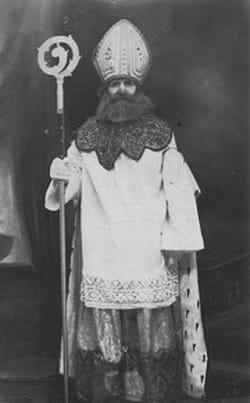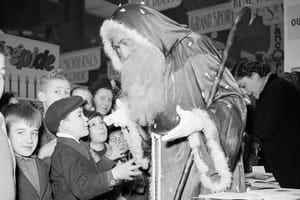SANTA CLAUS. From Saint Nicolas de Myre to red Santa Claus farting with Coke, then pagan green, the man with the long white beard has “mutated” more than once. Here are the secrets of its origin…
[Mis à jour le 20 décembre 2022 à 17h36] Who is really the Father Christmas ? This famous character with a white beard, dressed in red, from the 21st century comes from ancient (!) beliefs and rites (see below). Whether he is called “Santa Claus”, “Weihnachtsmann” or, more commonly, “Father Christmas”, the man who distributes presents to the four corners of the planet on the night of December 24 to 25, that of Christmas, has although known as the white wolf, his story is less so! And the fact that it has changed a lot since the beginning of its existence undoubtedly contributes to blurring the tracks! Alternately green, brown, yellow, blue, orange and pagan, or even embodied by the bishop Saint Nicolas of Myre before becoming the red Santa Claus of the United States and the punchy sales pitch of the Coca-cola brand, the Christmas ambassador has had one of the most eventful journeys: here is his story!

Why approach the story of Santa Claus starting with that of Saint Nicolas? For a simple reason: it is actually the ancient character of Saint Nicolas, the one who still brings gifts to small children in the North-Eastern quarter of Europe on December 6, who inspired that of modern Santa Claus. The CV of dear Saint Nicolas is more than provided : bishop of Myre (in Asia Minor, in the south-west of present-day Turkey) in the 4th century, he became in a second life, from the Middle Ages, the good Saint Nicolas, protector of schoolchildren and benefactor of good children in the end of the year. Miter on his head, crozier in hand and ecclesiastical habit on his back, according to legend, Bishop Nicolas de Myre performed many miracles, in particular by resuscitating three children cut into pieces by a cruel butcher.
Once he became a Saint, the former Santa Claus established himself in Northern and Eastern Europe (Lorraine, Netherlands) where he still visits children today to distribute candies in their asking if they were wise, accompanied by the faithful (and much less formidable than before) Père Fouettard. Thanks to the Dutch colonies landed on the new continent from the 17th century, Saint Nicolas was even exported to the United States where he would become Santa Claus (the American Santa Claus). American Christians then took up the tradition in their own way. by bringing the coming of Saint Nicolas closer to the birth of the Baby Jesus, on December 24: it is the modern version of the feast of Saint Nicolas. We are in the 19th century, the loop is complete, Santa Claus is born! Soon, “Small Santawhen you come down from the cieeeel…” will resound in the cottages on Christmas Eve. But not so fast, a long way still awaits him to become himself, equipped with his complete panoply of modern Santa Claus. And receive letters from little children who firmly believe in its existence and who hope to have a happy holiday season.
But how did we go from Saint Nicolas to the first Santa Claus, dressed in multiple colors? Our international Santa Claus started at the bottom of the ladder: from the beginnings of the cult of Saint Nicolas, a character accompanies him, presented as his valet in the regions of Germanic tradition. In the United States, he also made himself known out of the blue, this time in the guise of Saint Nicolas himself: in 1822, Clement Clarke Moore, a New York pastor, staged in colorful poems on “the visit of Saint Nicolas” a Santa Claus dressed in red, good-natured and smoking a pipe. A cap then replaces the bishop’s miter and the cape already evaporates under the warm fur coat. Many elements that will contribute to draw the legend of the man (already) dressed in red with the white beard already appear in the story: “It was Christmas Eve, a little before midnight”; “We hung our stockings in front of the chimney, So that Santa Claus finds them as soon as he arrives. “; “…outside, a sound of a bell”; “I could not believe my eyes when a sleigh and eight reindeer appeared in the distance”; “His fur coat, his boots and his cap (…) Thrown on his shoulder, a bag full of toys, gave him the air of a very curious merchant. He had rosy cheeks (…) And a very large beard of a really immaculate white ” ; ” he was in a hurry, Hastened to fill the stockings, to the last, And greeted me with a finger placed on the wing of the nose, Before disappearing into the chimney. I then heard him whistle his fine crew. (…) Before disappearing, Santa Claus shouted: “Merry Christmas to all and to all a good night”….

Clement Clark Moore also recounts the gift tour of the future Santa Claus on a sleigh pulled by eight reindeer (while the original Saint Nicolas traveled on the back of a donkey). Exported to the United States in the 19th century by Dutch emigrants, Sinter Klaas, Dutch Santa Claus, was transformed over the century by American writers and cartoonists into an old elf called alternately Saint Nick and Santa Claus and dressed in red, bAlthough this color is not yet final. In parallel, in Europe, various co-existing pagan figures represent him with different looks : in England, “Old Father Christmas” (inspired by the Germanic god Odin who was able to soar through the air on his flying horse) is represented with a green hooded cape and a plant crown on his head from the 17th century. Less engaging than the current Santa Claus, he symbolizes more the imminent arrival of spring than winter, according to the Quoi.info site. And does not distribute gifts (!) but goes from house to house for dinner promising all the same, if it is well received, to make the long winter months milder…
At the same time in France, Santa Claus, nicknamed “Bonhomme Noël” or “Père Janvier” depending on the region, is also often already dressed in a white and red suit but does not look healthy and wears bogeyman-style wands on the belt to frighten rambunctious children. In short, not really the Santa Claus we know today. In Germany, from the 16th century, once Saint Nicolas was banished from the country by the Protestant Lutheran Reformation against the figure of the saints, Christ Kind took over. It is a young girl with the appearance of a fairy and she distributes gifts. Little by little, these pagan representations mingle with those of “Saint Nicolas” already represented across the Atlantic as a bearded old man with good cheeks dressed in a red and white coat. The character of Christmas Eve is about to impose itself in homes, whether Christian or pagan. And the Coca-Cola brand will complete this popular image.
If Sinter Klaas transformed into Santa Claus was already generally represented in red in the country of Uncle Sam before the intervention of Coca-cola, the brand appropriated the character… and put it in red all over the world. As early as the 1930s, the Coca-Cola Company, which understood the advertising interest that Santa Claus could represent, launched a mega advertising campaign around the world. The muse of the campaign is none other than the chubby Santa Claus dressed in red and white, increasingly popular across the Atlantic, where Thomas Nast, a German emigrated to the USA, represented him in 1870 dressed in red and smoking a pipe. behind his white beard.

The American artist Haddon Sundblom was commissioned to draw it. Intensifying the good cheeks, good belly, good-natured look that we know worldwide today, he dresses Father Christmas in the colors of the famous bottle of Coca Cola : Red and white (trimmed with fur). And depicts him sipping the sweet carbonated beverage in large gulps to regain strength during the distribution of toys. What popularize the character to the four corners of the globe while extolling the merits of coke, including winter. A masterstroke. Besides, Coca-Cola’s XXL campaign will be broadcast as far as the southern hemisphere. Result: the inhabitants of these warm regions continue to imagine Santa Claus in the Nordic winter version and to visualize him with his fur and his hat. The modern Santa Claus will still take a little time to establish itself in France: in this Catholic country where Christmas has long been linked to the birth of Baby Jesus alone, the bearded benefactor was first popularized by the Americans. during the Second World War. And fully integrated into the 1950s when the booming Parisian department stores encouraged parents to buy gifts for their offspring in their windows… for December 25th. Today, Santa Claus has his quarters all over the world.
